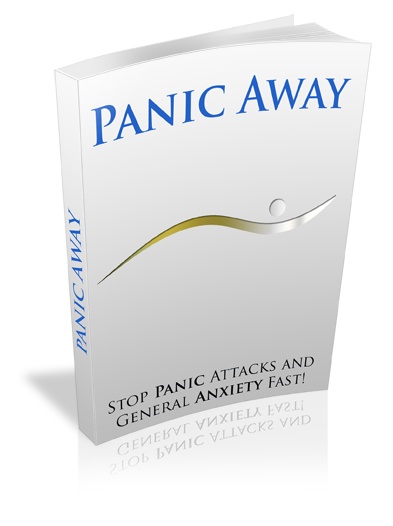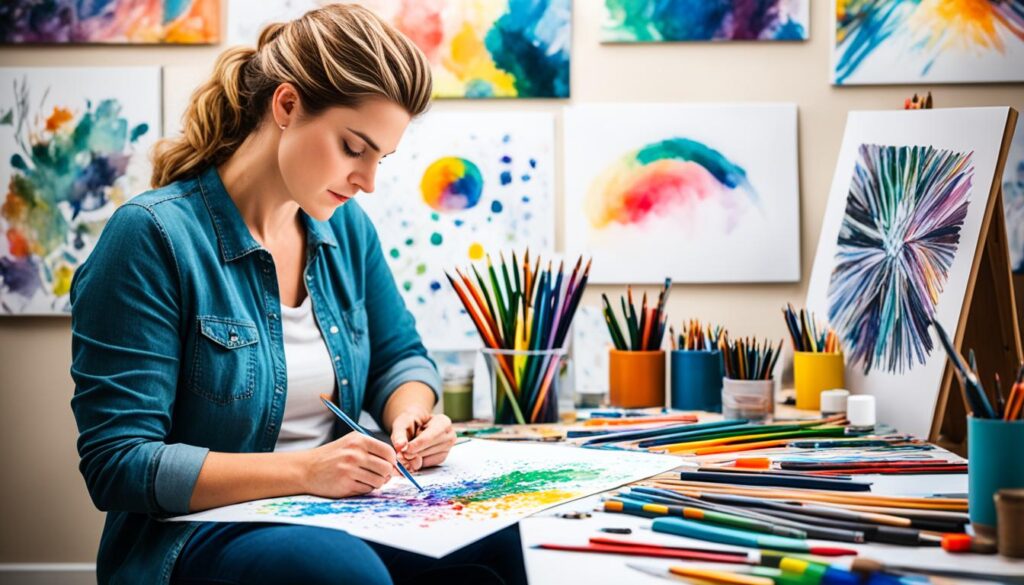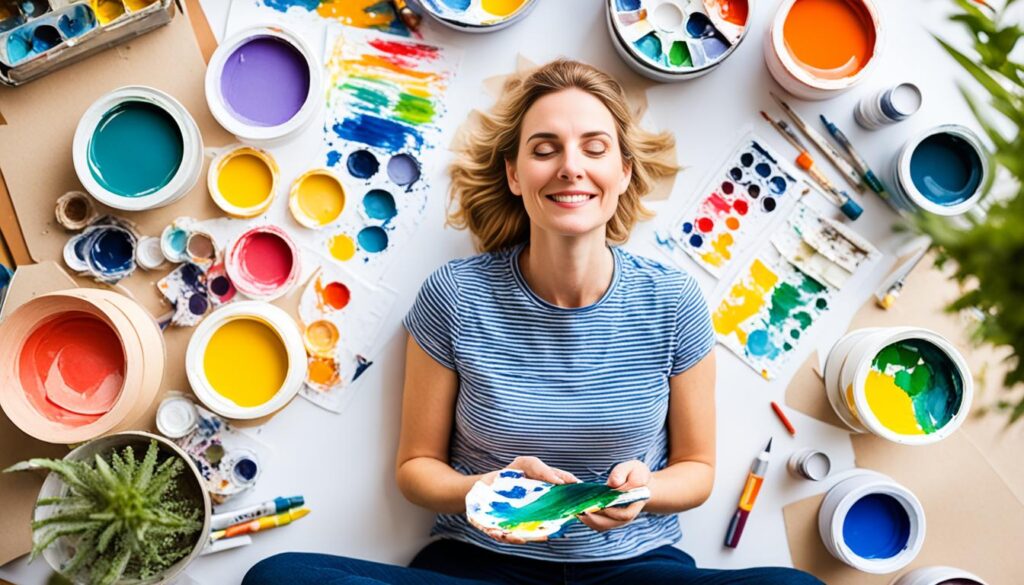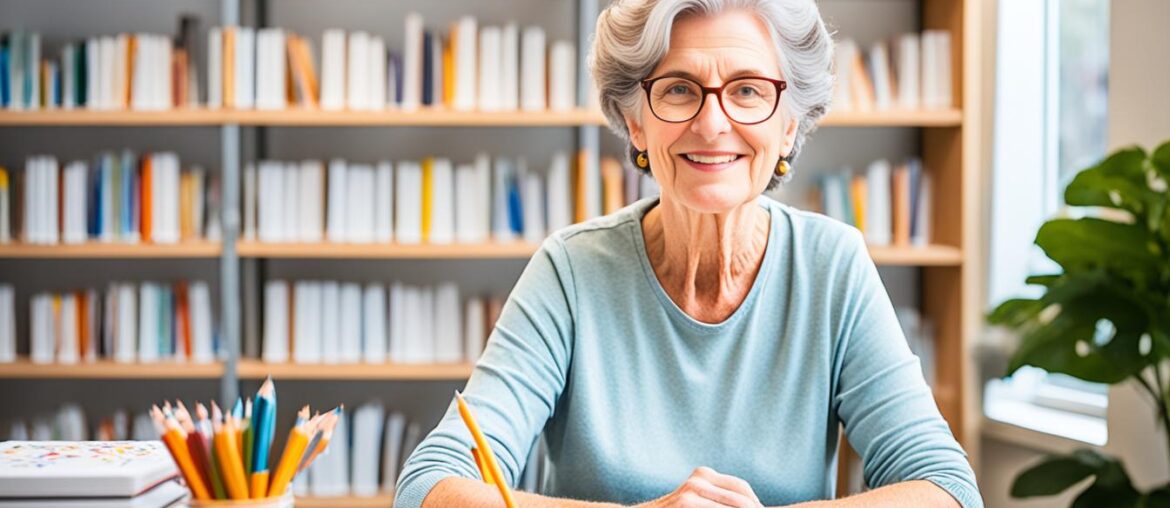I remember the first time I picked up a pencil and started drawing. It was a moment of pure escape, where my worries and anxieties seemed to fade into the background. The simple act of creating lines and shapes on a piece of paper brought me a sense of calm and clarity. In that moment, I realized the transformative power of art therapy for anxiety relief.
Art therapy offers a unique and powerful way to manage anxiety and promote emotional well-being. Through guided drawing exercises, you can tap into your creativity and use it as a tool for stress reduction and self-expression. Whether you're an experienced artist or have never picked up a pencil before, there are art activities and mindfulness drawing techniques that can help you find relaxation and peace.
Our Top Pick For Beating Panic Attacks

Stopping, and preventing, panic attacks is now even easier.
Art therapy for stress reduction involves using the process of creating art to explore and manage your anxiety. It allows you to express your thoughts and emotions visually, offering a different perspective and a release from the overwhelming thoughts that anxiety can bring. Guided art therapy sessions provide structure and support, guiding you through the process of creating art that promotes relaxation and helps you manage your anxiety.
Key Takeaways:
- Guided drawing exercises can be a powerful tool for anxiety relief.
- Art therapy offers a unique way to manage stress and promote emotional well-being.
- Mindfulness drawing techniques can help you find relaxation and peace.
- Art therapy provides a safe space to express and explore your emotions through art.
- Guided art therapy sessions provide structure and support for managing anxiety.
What is Anxiety
Anxiety refers to thought and behavioral issues that result from excessive fear and anxiety. It is a common human experience that can manifest both internally and externally. Anxiety may often be described by words such as stress, worry, or nervousness. Every day we live under some level of pressure where anxiety can sometimes help us to prepare for difficult or stressful times.
However, anxiety becomes a disorder when symptoms become chronic and disrupt daily functioning. It can cause poor concentration, poor memory, avoidance behaviors, and physical symptoms such as shortness of breath, sweaty hands, and weakness. In severe cases, it can lead to agoraphobia, generalized anxiety disorder, panic disorder, separation anxiety disorder, social anxiety disorder, or specific phobia, as classified in the DSM-5.
To manage anxiety, various relaxation techniques can be helpful, such as practicing hobbies, engaging in exercise, or finding entertainment that distracts from anxious thoughts. Coping mechanisms play a crucial role in alleviating anxiety symptoms and improving overall well-being.
It is important to remember that anxiety is a significant concern that affects many individuals. If you or someone you know experiences chronic anxiety, it is essential to seek proper diagnosis and professional guidance to ensure appropriate treatment.
https://www.youtube.com/watch?v=yhKL3CuUxNs
Benefits of Art Therapy for Anxiety
Art therapy offers numerous benefits for individuals who experience anxiety. By engaging in art activities, individuals can experience cognitive disruption as their attention is redirected away from rumination. Unlike verbal expression, which can be challenging for those with anxiety, art therapy provides a platform for visual expression, allowing individuals to express their thoughts and emotions in a non-verbal manner.
One of the key advantages of art therapy is its ability to promote relaxation and reduce stress. Art activities provide a calming and soothing experience, allowing individuals to tap into their creativity and find solace in the process. Through art therapy, individuals can also enhance their emotional regulation skills, learning how to manage and navigate through their anxiety in a healthy manner.
Moreover, art therapy can boost self-esteem by providing a sense of accomplishment and self-expression. Engaging in art projects allows individuals to explore their own creativity, problem-solving skills, and goal-setting abilities. This can be particularly beneficial for individuals with anxiety, as it empowers them to explore their strengths and build confidence.
Art therapy also serves as a powerful distraction from anxious thoughts. By focusing on the creative process, individuals can divert their attention away from overwhelming stressors and cultivate a greater sense of calm. The tactile stimulation provided by art materials, such as paint, clay, or markers, can further contribute to the calming effect of art therapy.
Another important benefit of art therapy is its capacity to act as a venting mechanism. Through art, individuals can externalize their anxious thoughts and emotions, providing a safe and non-judgmental outlet for expression. This can lead to a sense of emotional release and catharsis, allowing individuals to process their anxiety in a constructive and healthy manner.
Furthermore, art therapy offers a playful element that can help alleviate over-stimulation. Engaging in art activities allows individuals to tap into their imagination and embrace a sense of playfulness, providing a refreshing escape from the demands of daily life. By creating a space for play, art therapy encourages individuals to explore without pressure or judgment.
Overall, art therapy provides a wide range of therapeutic benefits for individuals struggling with anxiety. Through cognitive disruption, attention redirection, visual expression, and relaxation techniques, art therapy supports emotional regulation, self-esteem building, problem-solving, and goal setting. By serving as a distraction and a means of self-expression, art therapy empowers individuals to manage their anxiety and improve their overall well-being.

Therapeutic Benefits of Art Therapy for Anxiety
| Benefits | Description |
|---|---|
| Attention redirection | Art therapy facilitates cognitive disruption and redirects attention away from rumination. |
| Visual expression | Art therapy provides a platform for non-verbal expression, particularly beneficial for individuals with anxiety. |
| Relaxation | Engaging in art activities promotes relaxation and reduces stress. |
| Emotional regulation | Art therapy helps individuals develop skills to manage and regulate their emotions. |
| Self-esteem | Art therapy boosts self-esteem by fostering a sense of accomplishment and self-expression. |
| Problem-solving | Art therapy encourages individuals to explore their creativity, problem-solving abilities, and goal-setting skills. |
| Calming techniques | Art therapy serves as a calming and soothing experience, providing a break from anxiety-inducing thoughts. |
| Distraction | Engaging in art activities diverts attention away from overwhelming stressors and anxious thoughts. |
| Self-expression | Art therapy provides a safe outlet for individuals to express their thoughts and emotions. |
| Tactile stimulation | The use of art materials offers sensory stimulation, contributing to the calming effect of art therapy. |
| Venting | Art therapy provides a non-judgmental space for individuals to externalize their anxiety and emotions. |
| Play | Art therapy embraces a sense of playfulness and imagination, encouraging individuals to explore without pressure. |
| External sources | Art therapy offers a therapeutic outlet for individuals to process and manage anxiety. |
| Art activities | Engaging in art projects allows individuals to tap into their creativity and find solace in the process. |
| Therapeutic benefits | Art therapy promotes emotional well-being, self-expression, and stress reduction. |
Art Therapy Exercises for Anxiety
Art therapy provides a creative outlet for individuals with anxiety to express themselves and explore their emotions. Through a variety of exercises, individuals can engage in mindful art practices that promote relaxation and self-reflection. Here are some art therapy exercises specifically designed to help manage anxiety:
Mind-Body Connection
By engaging in art activities that involve the mind and body, such as creating art while practicing deep breathing or mindful movement, individuals can strengthen the connection between their thoughts and physical sensations, promoting a sense of calm.
1-Minute Brain Dump
A quick and effective exercise, the 1-minute brain dump involves setting a timer for one minute and drawing anything that comes to mind without judgment or analysis. This exercise helps release anxious thoughts and fosters a sense of mental clarity.
Mind Map Anxiety
Creating a mind map of anxiety triggers and related thoughts can help individuals gain insights into their worries and find patterns. This visual representation can serve as a starting point for addressing and managing anxiety.
Gratitude Journaling
Keeping a gratitude journal and integrating artwork into it helps shift focus from negative thoughts to positive experiences. By reflecting on and illustrating moments of gratitude, individuals can cultivate a more positive mindset.
Visual Starter
A visual starter is a simple mark or image that serves as a starting point for an artwork. This exercise helps individuals overcome creative blocks and initiate their artistic process, providing a sense of direction and inspiration.
Worry Cloud
The worry cloud exercise involves drawing a cloud and writing down worries or anxious thoughts inside it. This visual representation allows individuals to externalize their worries and gain a sense of control over them.
Comfort Castle
Creating a comfort castle involves drawing or collaging images that represent feelings of safety and comfort. This exercise helps individuals visualize a safe place they can mentally retreat to during moments of anxiety.
Mandala
Mandala drawing involves creating intricate patterns within a circular framework. This activity promotes focus, relaxation, and a sense of mindfulness, helping individuals reduce anxiety and find inner peace.
Creating Patterns
Engaging in pattern creation through drawing or collage can be soothing and meditative. This art therapy exercise allows individuals to channel their energy into creating repetitive designs, promoting a sense of calm and stability.
Affirmation Card
Designing affirmation cards involves creating visual representations of positive affirmations or self-empowering statements. This exercise encourages individuals to focus on self-care and boost their self-esteem.
These art therapy exercises provide individuals with anxiety a creative and therapeutic way to manage their symptoms. By engaging in these activities, individuals can explore their emotions, find relaxation, and develop coping strategies for maintaining their emotional well-being.
Drawing as a Form of Coping and Self-Care
Drawing can be a powerful tool for self-care and stress relief. It allows individuals to tap into their creativity, practice mindfulness, and express their emotions in a visual form. While not officially recognized as a therapy, drawing therapy has gained popularity as a method of coping and promoting self-care.
Many believe that engaging in art and creative activities can have healing effects on the mind and body. Drawing, in particular, provides a therapeutic outlet for releasing stress and anxiety. Through the process of creating art, individuals can enter a state of relaxation and find solace in their artistic expression.
To fully explore the benefits of drawing as a form of coping and self-care, it is important to understand the role of an art therapist. Art therapists are qualified professionals with art therapy credentials who use art media, the creative process, and resulting artwork as a part of the healing process. They guide individuals in using drawing and other art techniques to manage mental health conditions, work through trauma, and foster emotional well-being.
Through drawing, individuals can release anxiety, promote the healing process, and ignite the power of imagination. It serves as a creative outlet for those struggling with mental health conditions and can complement traditional psychotherapy methods. Drawing allows individuals to express their innermost thoughts and emotions, supporting their journey towards self-discovery and healing.
Art therapy offers various therapeutic benefits, making it an effective tool for managing stress, anxiety, and other mental health challenges. It provides an opportunity for relaxation, encourages emotional release, and fosters self-expression. Drawing as a form of coping and self-care can be accessible to anyone, regardless of their artistic abilities.
In the next section, we will explore the broader benefits of engaging in art for mental health. We will dive into the ways in which art and creativity can positively impact various aspects of well-being and provide a creative outlet for individuals seeking therapeutic benefits.

Now, let's delve into the benefits of art for mental health in more detail.
The Benefits of Art for Mental Health
Engaging in art has numerous benefits for mental health. Through creative expression, individuals can experience stress relief, improved mood, increased self-awareness, enhanced problem-solving skills, and improved communication skills. Art provides a unique and expressive language that speaks to both logic and emotions, allowing individuals to express themselves and regulate their emotions. This can contribute to overall well-being and emotional healing.
Art therapy activities and exercises further enhance the benefits of art for mental health. These activities provide structure and guidance for healing and self-exploration, allowing individuals to tap into their creativity, imagination, and unique identity. By engaging in art therapy, individuals can find solace, explore their emotions, and develop coping mechanisms for emotional regulation and stress relief.
Through art, individuals are able to tap into their creative potential, fostering imagination and self-expression. This process not only enhances problem-solving skills but also encourages individuals to explore their emotions and find healing. Art therapy can be a powerful tool in helping individuals develop a greater sense of self-awareness, enabling them to navigate their emotions more effectively.
The benefits of art for mental health extend to improved communication skills as well. Art acts as a visual and symbolic language, allowing individuals to communicate their experiences, thoughts, and emotions in a non-verbal way. This can be particularly beneficial for individuals who struggle with expressing themselves verbally. Art therapy provides a safe and supportive environment for individuals to explore and communicate their inner world, fostering improved communication skills and emotional well-being.
The creative process involved in art-making can be healing and therapeutic, providing individuals with a means of self-expression and emotional release.
Overall, the benefits of art for mental health are vast and varied. Engaging in art allows individuals to tap into their creativity, explore their emotions, and find healing. Whether through individual art practices or art therapy, art can play a significant role in promoting emotional well-being, stress relief, and personal growth. It is a powerful tool that can enhance problem-solving skills, increase self-awareness, and improve communication skills. By incorporating art into their lives, individuals can reap these benefits and cultivate a greater sense of mental health and well-being.
Using Art Therapy for Anxiety Management
Art therapy serves as a powerful tool for the management of anxiety and the regulation of emotions. Through the guided expressive journey of art therapy exercises, individuals can explore and address emotional blocks, particularly those associated with anxious attachment styles. This transformative journey towards emotional well-being harnesses the healing power of art and promotes mindfulness and self-reflection.
Art therapy provides a safe and supportive space for individuals to delve into their complex emotions and express them visually. With the guidance of a trained art therapist, individuals can navigate their anxious attachment patterns and develop a deeper understanding of their relationship with anxiety and attachment.
The transformative power of art therapy is amplified through the integration of mindfulness practices and self-reflection. By incorporating mindful awareness into the creative process, individuals can cultivate a deeper connection with their emotions and gain insights into the underlying causes of anxiety and attachment issues.
One approach in art therapy that supports this transformative journey is the concept of Soul-Centered Security™. This therapeutic framework recognizes the interplay between emotional regulation, attachment, and relationships. Through the expressive journey of art, individuals can deepen their understanding of themselves and their relationships, fostering emotional healing and growth.
Art therapy exercises tailored to anxiety management and emotional regulation offer individuals an opportunity to engage in self-exploration, expression, and healing. By tapping into their creativity, individuals can release pent-up emotions, gain new perspectives, and develop healthy coping mechanisms to manage anxiety.
Examples of art therapy exercises for anxiety management include:
- Creating a visual representation of emotional blocks and exploring ways to overcome them
- Using art to express and regulate anxious attachment behaviors and patterns
- Engaging in mindfulness-based art activities that promote relaxation and emotional well-being
- Exploring the transformative power of art to develop a more secure sense of self and build healthier relationships
This expressive journey through art therapy can lead to profound healing and growth, providing individuals with the tools to effectively manage anxiety and cultivate emotional well-being. By harnessing the transformative power of art, individuals can embark on a healing journey that nurtures attachment security and fosters a sense of inner harmony.

| Benefits of Using Art Therapy for Anxiety Management | Art Therapy Techniques for Anxiety Management |
|---|---|
|
|
Art Therapy Exercises for Healing Anxious Attachment Style
Art therapy exercises can be an effective tool for individuals with an anxious attachment style to address various emotional challenges. These exercises provide a structured approach to emotional exploration and healing, promoting enhanced self-esteem, trust development, and emotional well-being. Whether practiced individually or in a group setting, art therapy activities can play a significant role in the healing journey of those struggling with trust issues, emotional volatility, and emotional blocks.
Expressive art therapy activities offer a safe space for individuals with an anxious attachment style to engage in emotional exploration. Through the process of creative expression, deep-seated emotions and fears can be brought to the surface, allowing individuals to gain a better understanding of their internal struggles and find new ways to cope.
Art therapy exercises tailored to healing anxious attachment styles often focus on promoting emotional regulation and enhancing self-esteem. These activities may include:
- Confronting the “Inner Critic” through expressive painting: This exercise encourages individuals to visually represent their negative self-talk and inner insecurities. By externalizing these emotions, individuals can gain a fresh perspective and develop a more compassionate approach towards themselves.
- Creating a “Trust Anchor” in clay: This activity involves sculpting a symbolic representation of trust and stability. By shaping an object that embodies trust, individuals can work towards building a stronger sense of trust within themselves and their relationships.
- Engaging in art therapy mindfulness activities such as mandala drawing: Mandala drawing promotes self-reflection, relaxation, and emotional exploration. By focusing on the creation of intricate patterns and designs, individuals can find a sense of peace and balance while connecting with their inner selves.
These art therapy exercises for healing anxious attachment styles can be adapted to both individual and group settings, depending on the needs and preferences of the participants. Additionally, these exercises can be particularly beneficial for addressing trauma and attachment issues, providing individuals with a creative outlet for processing their emotions and promoting healing.
By incorporating art therapy techniques into their healing journey, individuals with an anxious attachment style can make significant strides towards emotional well-being and Soul-Centered Security™. Art therapy offers a unique and powerful avenue for emotional exploration and self-expression, allowing individuals to transcend emotional barriers and foster personal growth.
Incorporating Art Therapy into Your Life
Art therapy is a powerful tool that can be incorporated into your daily life to enhance self-care and provide stress relief. By engaging in art therapy exercises and activities, you can tap into your creativity, practice mindfulness, and explore emotional expression. These practices can promote emotional well-being and relaxation, allowing you to manage and alleviate stress in a holistic way.
One way to incorporate art therapy into your life is through art journaling. This practice involves creating a visual diary where you can express your thoughts and emotions through art. Whether it's drawing, painting, or collaging, art journaling allows for a deep exploration of your inner self and acts as a form of self-reflection.
Another way to benefit from art therapy is by engaging in art therapy mindfulness activities. These activities combine the therapeutic benefits of art with mindfulness practices, such as focused breathing and body awareness. By immersing yourself in the creative process and being present in the moment, you can experience a sense of calm and relaxation.
Art therapy also provides a space for emotional exploration and expression. Through various art exercises, you can delve into your emotions, release pent-up feelings, and gain a better understanding of yourself. Whether it's creating art that represents your emotions or engaging in art techniques that promote emotional release, art therapy allows for a safe and supportive environment to express and process your emotions.
Incorporating art therapy into your life can be done individually or in a group setting. Participating in art therapy group activities can foster connection, provide a sense of community, and offer support from others who may be experiencing similar challenges. Working with a qualified art therapist can provide guidance, facilitate the therapeutic process, and help you navigate your emotional well-being.
| Benefits of Incorporating Art Therapy into Your Life |
|---|
| Stress Relief |
| Self-Care |
| Mindfulness Practice |
| Emotional Expression |
| Relaxation |
| Creativity |
| Art Journaling |
| Art Therapy Mindfulness Activities |
| Emotional Exploration |
| Emotional Well-being |
| Expression |
| Art Therapy Group Activities |
| Art Therapist |
By incorporating art therapy into your life, you can embark on a transformative journey of self-discovery, emotional well-being, and personal growth. Whether you engage in art journaling, practice mindfulness through art, or participate in art therapy group activities, art therapy offers a powerful pathway for self-care and self-expression.
Conclusion
Art therapy, specifically through guided drawing exercises, is a powerful tool for relieving anxiety and promoting healing. By incorporating art therapy into daily life, individuals can experience the benefits of mindful art exercises, such as stress reduction, self-expression, and emotional well-being.
Art therapy provides a unique avenue for self-expression and allows individuals to explore their emotions in a safe and creative space. Through this process, they can find relaxation and tap into their creativity, which can be incredibly therapeutic. Guided drawing exercises offer a mindful approach to engage with art, helping individuals manage their anxiety and improve their overall mental health.
By practicing art therapy techniques regularly, individuals can develop valuable tools to navigate anxiety and cultivate emotional well-being. Whether it's creating art journal entries, participating in art therapy group activities, or simply engaging in art for self-care, art therapy offers a holistic approach to managing anxiety and finding inner balance. With art as a companion, individuals can embark on a meaningful journey of self-discovery, healing, and personal growth.
FAQ
What is anxiety?
Anxiety refers to thought and behavioral issues that result from excessive fear and anxiety. It may often be described by words such as stress, worry, or nervousness. Anxiety becomes a disorder when symptoms become chronic and disrupt daily functioning. Anxiety can manifest both internally and externally and is classified into various subtypes in the DSM-5.
How does art therapy help with anxiety?
Art therapy helps facilitate cognitive disruption by moving attention away from rumination. It allows for visual expression and relies less on verbal expression, which can be difficult for those with anxiety. Art therapy can calm the nervous system, act as a distraction, interrupt rumination, encourage focus, increase self-esteem, reduce over-stimulation, provide tactile stimulation, and serve as an outlet for venting and stress release. It can also be used as a tool for problem-solving, goal setting, and encouraging play.
What are some art therapy exercises for anxiety?
Art therapy exercises for anxiety include mind-body connection, 1-minute brain dump, mind map anxiety, gratitude journaling, visual starter, worry cloud, comfort castle, mandala, creating patterns, and affirmation card. These activities help individuals explore the mind-body connection, dump anxious thoughts, map out anxiety triggers, journal gratitude, start artwork with a visual prompt, release worries through a cloud drawing, create a comfort castle, draw mandalas, create patterns, and design affirmation cards.
What are the benefits of art therapy for anxiety?
Engaging in art has positive benefits on mental health, including stress relief, improved mood, increased self-awareness, enhanced problem-solving skills, and improved communication skills. Art provides an expressive language that speaks to both logic and emotions and can help regulate emotions and promote well-being. Art therapy activities and exercises can enhance the benefits of art for mental health by providing structure and guidance for healing and self-exploration.
How can art therapy be used for anxiety management?
Art therapy can be used as a tool for anxiety management and emotional regulation. It offers a safe space for exploring and expressing complex emotions and can help individuals navigate anxious attachment styles. Art therapy exercises, coupled with mindfulness and self-reflection, can facilitate a transformative journey towards emotional well-being and the development of Soul-Centered Security™.
How can art therapy help heal anxious attachment styles?
Art therapy exercises can help individuals with anxious attachment style address self-esteem issues, trust issues, emotional volatility, and emotional blocks. These exercises provide a structured approach to emotional exploration and healing, promoting emotional well-being and Soul-Centered Security™. Art therapy exercises can be adapted for both individual and group settings and can be particularly beneficial for addressing trauma and attachment issues.
How can art therapy be incorporated into daily life?
Art therapy can be incorporated into daily life as a form of self-care and stress relief. Activities such as art journaling, engaging in art therapy mindfulness activities, and exploring emotional expression through art can promote emotional well-being and relaxation. Art therapy can also be practiced individually or in group settings, and working with a qualified art therapist can provide guidance and support in the therapeutic process.
What is drawing therapy and how does it help with anxiety?
Drawing can be an act of self-care, releasing stress, boosting creativity, and promoting mindfulness. Drawing therapy, while not an official name, involves using drawing as a form of coping and self-care. Many believe that art and other forms of creativity can be healing and help release stress and anxiety. Art therapy is a certified practice that uses art media, the creative process, and resulting artwork as a therapeutic and healing process. It can be used to manage mental health conditions, trauma, and promote emotional well-being.
What are the benefits of art for mental health?
The benefits of art for mental health include stress relief, improved mood, increased self-awareness, enhanced problem-solving skills, and improved communication skills. Art provides an expressive language that speaks to both logic and emotions and can help regulate emotions and promote well-being.
How can art therapy be used for anxiety relief and healing?
Art therapy, particularly guided drawing exercises, can play a significant role in anxiety relief and healing. It offers a mindful approach to self-expression and can promote emotional well-being and stress reduction. By incorporating art therapy techniques into daily life, individuals can explore their emotions, find relaxation and creativity, and develop tools for managing anxiety and improving overall mental health.



